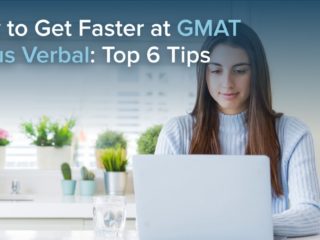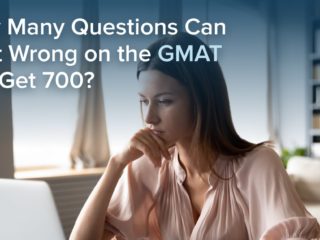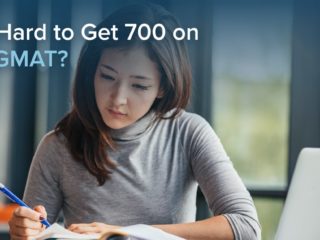Last Updated on November 23, 2023
A question we field a lot at TTP is how to get faster at GMAT quant questions. Unfortunately, there is no “one size fits all” approach to getting faster at GMAT quant. However, several strategies, if properly executed during your prep and on the exam, can help you accurately speed up when solving GMAT quant questions.
Here are the topics we’ll cover:
- The GMAT Quant Section
- Why It Won’t Help to Rush Through GMAT Quant Questions
- What a Navy SEAL Motto Can Teach Us About Working Through the GMAT Quant Section
- Tip 1: At the Beginning of Your Preparation, Do Not Worry About the Clock
- Tip 2: Know GMAT Quant Like the Back of Your Hand
- Tip 3: Take a Topical and Linear Approach to Your Studying
- Tip 4: Memorize Quant Facts, Formulas, and Equations
- Tip 5: Flashcards Will Help You Memorize Key Quant Formulas and Concepts
- Tip 6: Get Used to Answering Questions About Various Topics in One Sitting
- Key Takeaways
- What’s Next?
Let’s begin by discussing the format of the GMAT quant section.
The GMAT Quant Section
The quant section on the GMAT consists of 31 questions with a time limit of 62 minutes. Thus, you have an average of 2 minutes to complete each math question. That said, the 2 minutes is just an average! For example, some questions may take 35 seconds while others may take 3.5 minutes.
KEY FACT:
You have an average time of 2 minutes to answer each GMAT quant question.
Next, let’s discuss why rushing on GMAT quant questions is not the best idea.
Why It Won’t Help to Rush Through GMAT Quant Questions
Consider almost anything you do — driving, writing emails, even making pancakes. When completing those activities, would you say that hurrying causes more mistakes than taking your time causes? I think we’d agree that rushing generally leads to more errors.
Well, I have some news for you: the GMAT is no different! In my experience, when a student rushes through a question, a wrong answer is far too often the result. This should not be shocking, as rushing teaches your brain to work irresponsibly. Thus, it should be clear that rushing through the GMAT quant section will lead to a lower score.
TTP PRO TIP:
Rushing will cause more wrong answers, in turn causing a low quant score.
What a Navy SEAL Motto Can Teach Us About Working Through the GMAT Quant Section
Thus far, we’ve learned that rushing for the sake of rushing will not do you any favors on the GMAT quant section. Remember, you don’t get any extra points by being the first to complete the GMAT quant section, right? Rather, your goal is to complete as many GMAT quant questions as possible while completing the section in a timely manner.
Think about this Navy SEAL motto: slow is smooth, and smooth is fast. Following this motto when working through GMAT quant will help you move with efficiency and care, and ultimately help you avoid costly mistakes.
But let’s be clear about one thing: slow does not necessarily mean a crawl. Work with a comfortable level of speed and precision when you work through a GMAT quant question. You can work fast and still be precise by working with an efficient tempo.
TTP PRO TIP:
Find the right balance of speed and precision when working through the GMAT quant section.
Next, let’s discuss how to become faster while maintaining accuracy.
Tip 1: At the Beginning of Your Preparation, Do Not Worry About the Clock
When starting your prep, prioritize comprehending the content more than finishing each question in 2 minutes or less. Furthermore, don’t worry about the clock when practicing questions from a newly learned topic.
Going slowly will help you gain accuracy and confidence, eventually enabling you to improve your speed when solving GMAT quant questions naturally.
TTP PRO TIP:
Prioritize accuracy over speed when first practicing GMAT quant questions.
Tip 2: Know GMAT Quant Like the Back of Your Hand
It should be no surprise that you will move more quickly and accurately through GMAT quant the better you understand the material. In fact, you’d be shocked how many students forget this idea in their quest to become faster on the GMAT quant section. They overlook the fact that their lack of content mastery is the reason they are slow!
TTP PRO TIP:
Speed comes with content knowledge.
Tip 3: Take a Topical and Linear Approach to Your Studying
If you’ve put any time into studying GMAT quant, I’m sure you’ve seen the vast amount of material you must learn. A great way to learn so much content is to learn one topic at a time and answer practice questions on just that topic until you have achieved mastery.
If you’re wondering why you should study only one topic at a time, ask yourself: would it be practical to jump from ratios to rates to probability? Of course not! To truly learn each GMAT quant topic, you must take time, effort, and care. So, again, focus on just one topic until it’s mastered.
To illustrate the topical approach, let’s use the example of rates. First, you will learn about all the rates topics, such as average rates, converging rates, catch-up rates, and catch-up and pass rates, to name a few. Once you have those topics mastered, you will practice just rates questions. After so much focused learning and practice, you should be able to crush any rates question that comes your way on test day.
TTP PRO TIP:
Using a topical study approach is a fantastic way to learn GMAT quant.
Let’s now discuss how topical learning leads to greater speed.
Speed Comes from Recognition and Execution
Topical learning will make you an expert in any topic you learn. By becoming an expert, you develop the ability to a) quickly recognize and then b) execute a plan of attack when solving problems.
For example, take the quant topic of units digit patterns. While such a topic may seem challenging at first, imagine how “automatic” answering units digit pattern questions will be if you learn about the concepts related to those questions, and then practice 30+ units digit patterns questions. You’ll easily recognize when you have a units digit pattern question and quickly execute when solving the problem.
TTP PRO TIP:
Speed on GMAT quant is entirely based on recognition and execution.
Let’s practice with a couple of examples.
Example 1
The probability that event A occurs is 2/3, and the probability that event B occurs is 1/5. If events A and B are independent, what is the probability that neither event occurs?
- 2/15
- 4/15
- 7/15
- 13/15
- 17/15
Solution:
Recognition: If you have probability down cold, you should be able to quickly recognize that you are dealing with a scenario for which the multiplication rule for independent events will be used.
Execution: Once you recognize that you have to find the probability that neither event occurs, you execute by using the multiplication rule for independent events.
Now, let’s discuss how to solve the above problem.
We have a probability problem that uses the following formula:
P(neither event occurs) = P(event A does not occur) x P(event B does not occur)
We know that P(A) = 2/3, so the complement of this event (i.e., the probability that event A does not occur) is P(not A) = 1 – 2/3 = 1/3. Similarly, we know that P(B) = 1/5, so the complement of this event (i.e., the probability that event B does not occur) is P(not B) = 1 – 1/5 = 4/5.
Now we plug these two values into the formula:
P(neither event occurs) = P(event A does not occur) x P(event B does not occur)
P(neither event occurs) = 1/3 x 4/5 = 4/15.
Answer: B
Example 2
What is the units digit of 322?
- 9
- 7
- 3
- 1
- 0
Solution:
Recognition: If you have spent time mastering units digits patterns, you’ll get a big smile on your face when you see this problem!
Execution: Because you have a units digits pattern question, you execute by recalling and using the pattern for positive integer powers of 3.
Now, let’s discuss how to solve the above problem.
Recall that the pattern for the units digits of powers of 3 is 3-9-7-1. In this pattern, every power to which 3 is raised that is a multiple of 4 has a units digit of 1.
We need to determine the units digit of 322.
First, we note that the units digit of 320 must be 1, since the exponent 20 is a multiple of 4. Next, the units digit of 321 must be the next number in the pattern, which is 3. And finally, the units digit of 322 is the next number in the pattern, which is 9.
Answer: A
TTP Does Topical Learning
Let’s refer to the TTP study plan for a good example of topical learning. Take our chapter on linear and quadratic equations, for instance. First, you learn about subtopics such as single- and multi-variable equations, factoring quadratic equations, FOILing, quadratic equations in fractions, factoring by grouping, the difference of squares, etc. Additionally, you are presented with 3 to 4 questions to practice immediately after learning about each subtopic.
After finishing the entire Linear and Quadratics chapter, you proceed through a series of easy, medium, and hard chapter tests. Thus, you can ensure mastery before moving on to the next chapter.
Let’s next focus on how learning even the smallest, most seemingly unimportant formulas can increase your GMAT quant speed.
Tip 4: Memorize Quant Facts, Formulas, and Equations
I find myself constantly reminding my students that despite how insignificant and nuanced a formula may seem, it still needs to be committed to memory for the GMAT. In other words, when you think something won’t appear on your exam, it will! So, you must learn these formulas and be able to pull them out, when necessary, on the GMAT. In addition, doing so will allow you to solve GMAT quant questions faster. Let’s practice a few examples to get an idea of what I mean.
Example 1
12! is equal to which of the following?
- 391,713,826
- 446,927,315
- 479,001,600
- 485,318,381
- 489,916,804
Solution:
The Concept to Memorize: The units digit (or ones digit) of any factorial greater than 4! is zero. Let’s see how quickly we answer this question when using that rule.
Solution:
Since 12! is greater than 4! (based on the rule), we know that its units digit must be zero. Thus, since C is the only answer choice with a units digit of zero, it must be the correct answer.
Answer: C
Example 2
What is the product of a and b?
- The greatest common factor of a and b is 12.
- The least common multiple of a and b is 60.
- Statement (1) ALONE is sufficient but statement (2) alone is not sufficient.
- Statement (2) ALONE is sufficient but statement (1) alone is not sufficient.
- BOTH statements TOGETHER are sufficient, but NEITHER statement ALONE is sufficient.
- EACH statement ALONE is sufficient.
- Statements (1) and (2) TOGETHER are NOT sufficient.
Solution:
The Concept to Memorize: The product of the greatest common factor and least common multiple of two numbers is equal to the product of those two numbers. Let’s see how quickly we answer this question when using that rule.
Now, let’s move to the solution:
We see that we need to determine the product of and b. Just glancing at the statements should hint that we likely will use the above rule.
Statement (1) Alone:
⇒ The greatest common factor of a and b is 12.
Just knowing the greatest common factor of a and b does not provide the values of a and b or the product of a and b. Thus, statement one is not sufficient.
Eliminate answer choices A and D.
Statement (2) Alone:
⇒ The least common multiple of a and b is 60.
Just knowing the least common multiple of a and b does not provide the values of a and b or the product of a and b. Thus, statement two is not sufficient.
Eliminate answer choice B.
Statements (1) and (2) Together:
Using the rule above:
The product of the greatest common factor and least common multiple of two numbers is equal to the product of those two numbers.
Thus, the product of a and b is 12 ⨉ 60 = 720. Statements (1) and (2) together are sufficient to answer the question.
Answer: C
Example 3
Of the numbers below, which of the following is not a perfect square?
- 39,601
- 46,225
- 52,441
- 58,564
- 66,047
Solution:
The Concept to Memorize: Perfect squares will have units digits (or ones digits) of only 0, 1, 4, 5, 6, and 9. Let’s see how quickly we answer this question when using that rule.
Solution:
Using the rule above, we need to find the answer choice that does not have a units digit of 0, 1, 4, 5, 6, or 9. Since a perfect square cannot have a units digit of 7, we see that 66,047 cannot be a perfect square.
Answer: E
Tip 5: Flashcards Will Help You Memorize Key Quant Formulas and Concepts
We can all agree that knowledge of GMAT quant topics will help you become faster. Furthermore, creating and using flashcards will be a game-changer for retaining all you learn as you move through your study plan. In fact, you will come across a ton of rules and concepts that need to be recalled for success on the GMAT. And there is no better way to instill them in your memory than by using flashcards.
For instance, you don’t want to waste time trying to recall the formula for the area of an equilateral triangle or the formula used for converging distance problems. Rather, you want to be able to recall those concepts quickly and effortlessly!
TTP PRO TIP:
Use flashcards to help you recall important rules and concepts.
Next, let’s discuss why it’s important to get comfortable answering a random array of questions.
Tip 6: Get Used to Answering Questions About Various Topics in One Sitting
While it is imperative to use a topical approach when learning the content, it is crucial to remember that you will come across a wide range of questions from various topics in the GMAT quant section.
For example, on your exam, question 1 could ask you about a 3-part ratio, question 2 could be a rate question, and question 3 could test you on slope. Thus, some of your preparation must be geared toward solving questions from random topics.
So, as you move through your study plan, make sure that in addition to your topical learning, you complete mixed problem sets. Your ability to recall concepts and formulas when doing these sets will help you become faster at answering GMAT quant questions. Do these sets often throughout your prep.
TTP PRO TIP:
Practicing with mixed problem sets throughout your prep will help improve your retention and speed.
Finally, let’s discuss the importance of taking practice tests.
Take All the Official Practice Exams
Up to this point, we have discussed how a great study plan consists of topical learning and practice, flashcard review, and mixed problem sets. All these things will help you become faster at solving GMAT math problems. However, there is one more piece of the puzzle to consider, and that is taking practice exams.
Taking practice exams will allow you to put your skills to the test and ensure that you can, in fact, quickly and accurately answer GMAT quant questions. GMAC offers a total of 6 practice exams on mba.com, and we suggest taking all 6 of them.
Make sure to simulate test-day conditions when taking each practice exam. Follow all test-day rules and finish the exam in one sitting. In essence, approach your practice exams the same way you would the actual GMAT!
TTP PRO TIP:
At the end of your prep, ensure that you take all 6 mba.com practice exams.
Key Takeaways
Here is a summary of tips you can use during your GMAT prep in order to answer quant questions faster:
- Make your first priorities understanding and accuracy rather than speed.
- Know the material cold, allowing you to quickly know the correct approach to solve a problem.
- Use a topical study plan, which allows for development of quick recognition and execution skills.
- Memorize facts, formulas, and equations.
- Use flashcards to support your learning and memorization.
- Do many mixed practice sets and practice tests to get used to changing topics from one question to the next.
What’s Next?
In this blog, we have focused on getting faster at GMAT quant. Of course, this is just one aspect of earning a great GMAT score. You may also want to read this article about improving your overall GMAT score.



